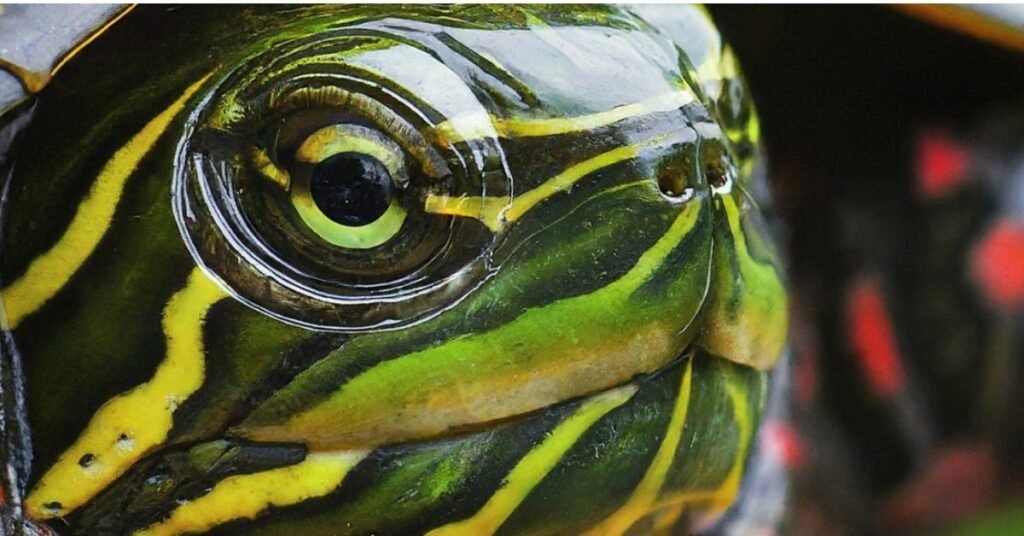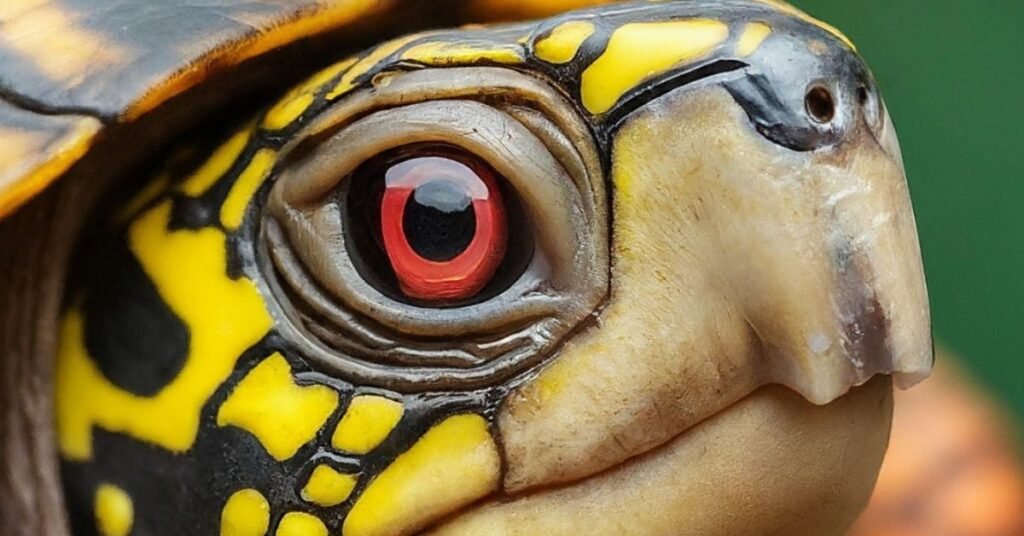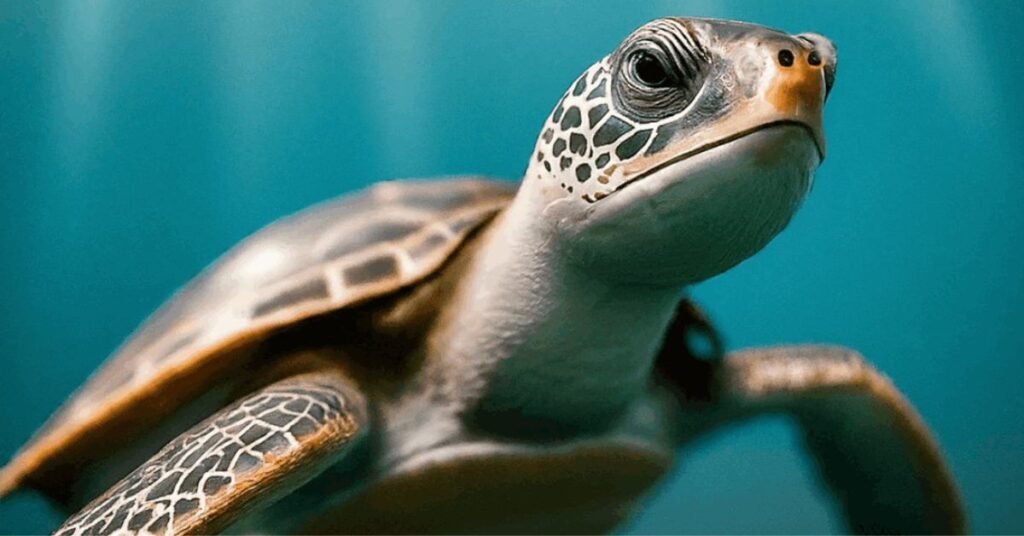Turtles are quite interesting reptiles with their unique physical structure. Some of their unusual physical attributes include a hard armored shell and a toothless jaw, which means turtles do not have teeth. This type of attribute creates curiosity about other turtles’ physical feature-related questions, such as “Do turtles have noses or a smelling sense?
While some reptiles, like snakes, don’t have noses, turtles do. If you notice a turtle’s front face, you will see two tiny holes. Turtles’ noses, or smell-sensing ability, help them navigate their surroundings. So, today, we will be delving into the specifics: do turtles have noses? Can they smell like us? What is their nasal anatomy?
Table of Contents
Do Turtles Have Noses?

Yes, turtles have noses with two tiny nostril holes. However, turtles’ nose structure is not like that; their nose anatomy is different. Turtles’ tiny nostril openings are located on the top of their heads, right above their beak. You might miss them at first glance, but they’re critical to a turtle’s sense of smell.
These nostrils aren’t only for breathing, though. Turtles can also breathe through their throats. But their excellent noses do a whole lot more. They use them to sniff out yummy food in the water or on land. Imagine a turtle hunting for a tasty worm in the mud; its super sniffer comes in handy.
Turtle Nose Anatomy
Turtles have a fascinating nasal anatomy; if you dive into it, you may feel surprised. Like any other animal, turtles’ nasal anatomy and ability are very important in their survival and interaction with the environment.
External Anatomy – Visible Tiny Holes
Turtles have external nostrils, called nares, located at the tip of their snouts. This part is visible. If you notice it carefully, you will see it. These nares are the entry points for air into the nasal cavity, and this tiny nostril initiates their respiratory process. The structure of the external nares varies between species.
Inside Nasal Anatomy – From Nose to Lungs
Right behind those visible tiny nostrils, there’s a hidden tunnel inside the turtle’s skull called the nasal passage. This passage is like a unique air highway that carries the air we talked about earlier. It leads all the way down to the turtle’s lungs, where the air gets used for breathing.
For example, sea turtles have an extra cool feature on their air highway. They have special glands that act like tiny filters. These glands help them get rid of extra salt they might swallow when drinking seawater. It keeps their body chemistry balanced, just like sugar in a tasty drink. Freshwater turtles don’t need to worry about all the extra salt like their sea turtle cousins.
Olfactory System (Smell Senese Organs)
While a turtle’s nose might not be as prominent as a bloodhound’s, their smelling sense is quite good compared to many other animals. So, which organs help turtles to smell good?
They have two particular organs that take their sense of smell to an optimum level:
- Jacobson’s Organ – The Super Smell Booster
Imagine a built-in taste bud booster, but for smell, what? That’s what Jacobson’s organ is like for turtles. It’s on the roof of their mouth, near the tongue, and it helps them analyze scents in incredible detail. It’s like giving their regular sense of smell a supercharge.
- Vomeronasal Organ: Decoding the Chemical Messages
Vomeronasal organ—This other excellent organ exists inside the turtle’s nasal cavity. It acts like a decoder ring for unique scents called pheromones, which are chemical messages that other turtles release into the air. The vomeronasal organ helps them understand these messages, which could be anything from danger to food-hunting senses.
Functions of Turtle Noses

Turtles can do many things with their noses, like breathing and smelling. Let’s examine some of the crucial functions of turtle noses.
Breathing
Turtles use their noses to breathe, which is essential for aquatic species that need to surface for air. Their nostrils, located at the tip of their snout, let them breathe while keeping most of their bodies submerged. In their respiratory system, the nostrils are connected to the nasal cavity. It leads to the lungs through the glottis and trachea, which allows efficient respiration.
Sense of Smell
The sense of smell is vital for turtles. They rely on their olfactory senses to locate food, identify mates, and detect potential dangers. Their nostrils and nasal passages are adapted to filter and detect various scents from their environment. For instance, sea turtles have specialized glands in their nasal passages to excrete excess salt. It helps them drink seawater without disrupting their blood chemistry.
Foraging or Hunting for Food
Turtles use their claws and sense of smell to forage or hunt for food. Even in murky water or dense foliage, they can detect food sources by using their tongues. Jacobson’s organ makes finding their prey easier because it breaks down chemical signals into detail.
Protection
Turtles’ claws and their sense of smell also play a role in protection. When turtles smell predators or danger, they react quickly to avoid getting hurt. Along with their sense of smell, their sharp claws are used not only for digging and climbing but also for defense against potential threats .
How Many Breathing Mechanisms Have Turtles Adapted?

Turtles might seem like simple creatures, but they have surprising breathing tricks. In addition to their lungs, some turtle species have developed other ways to take in oxygen, especially underwater. Let’s look at turtle respiration mechanisms.
Lung Respiration
Just like humans, some turtles breathe air through their lungs. They have nostrils located at the top of their snout, which act as air intake valves. These nostrils connect to a respiratory system that leads to the lungs. Their lungs expand and contract with help from muscles (like the diaphragm) in their bodies.
Cloacal Respiration – Breathing Through Their Butts
Some turtles, especially those that spend a lot of time underwater, have cloacal respiration as a backup breathing system. Now, this might sound strange, but it is a unique turtle-breathing adaptation.
The cloaca is a multi-purpose opening in a turtle’s body used for waste elimination and reproduction. However, in some species, the cloaca also contains richly vascularized tissue – basically, tissue with lots of blood vessels. When underwater, turtles draw oxygen from the water through this tissue in their cloaca. It’s not precisely “breathing through their butts,” but it lets them get oxygen directly into their blood.
This cloacal respiration is particularly beneficial for aquatic turtles like snapping turtles, painted turtles, and some mud turtles. They can use it to stay submerged for longer periods, especially during hibernation, when their bodies slow down and their oxygen needs decrease.
Buccal Pumping
Some aquatic turtles, like the red-eared slider, use buccal pumping to enhance their oxygen intake. This involves regularly moving their mouth and throat muscles to draw water into their mouth cavity. The water then passes through blood vessels in their mouths, allowing them to absorb oxygen directly into the bloodstream.
Breathing Mechanisms of Different Types of Turtles
| Type of Turtle | Breathing Mechanism | Additional Information |
| Land Turtles | Use their lungs to breathe. Movements of limbs aid in lung ventilation. | Land turtles, such as tortoises, cannot expand and contract their ribcage due to their fused ribs. They use muscle contractions to push air in and out of their lungs, often seen as a “rocking” motion. |
| Freshwater Turtles | Dual breathing system: use lungs for air-breathing and cloacal respiration for underwater oxygen absorption. | Freshwater turtles, such as painted turtles and snapping turtles, absorb oxygen through the skin in their cloaca. This helps them stay submerged for extended periods, especially during hibernation. |
| Sea Turtles | Large lungs for rapid air intake; specialized muscle structure around lungs aids in buoyancy control. | Sea turtles, including loggerhead and leatherback turtles, can hold their breath for about 40 minutes to several hours. They have efficient gas exchange capabilities and utilize muscle structures to control buoyancy, crucial for diving and surfacing. |
| Box Turtles | Use lungs for respiration. | Box turtles, are primarily terrestrial but sometimes found in water. They use the muscular breathing method common among land turtles. However, their dome-shaped shell does not support the same level of water adaptation seen in other freshwater or sea turtles. |
Do Sea Turtles Have Noses?
Yes, sea turtles do have noses. The little openings at the top of their snout are called nostrils. Sea turtles need their noses as much as other animals do. Sea turtles use their nostrils to take in air, just like us. The air travels through these openings and down to their lungs for breathing.
Do Ninja Turtles Have Noses?
The Teenage Mutant Ninja Turtles, also known as TMNT, are a totally tubular group of heroes. They’re not real animals but rather fictional characters who originated in comic books and became popular in cartoons, movies, and video games. While based on real turtles, the Teenage Mutant Ninja Turtles have a fictional body structure as well as a nose.
Do Pig-nosed Turtles Have Gills?
No, the pig-nosed turtle, also known commonly as the Fly River turtle, the pitted-shelled turtle, and the Warrajan, doesn’t have gills. Even though it is fascinating, with a long snout that resembles a pig’s nose, it breathes air just like other turtles.
Read More: Do Turtles Have Claws?
Bottom Line
Turtles seem like simple creatures, happy to munch on lettuce and soak up the sun. But there’s a surprising amount of complexity underneath those shells! Sometimes, you might wonder, “Do turtles even have noses?” because their nose pattern is not focused enough to notice. The answer is yes. These tiny holes in their snouts might seem insignificant, but they’re their survival organs. Turtles use their nostrils to breathe and smell, which helps them navigate their environment.
